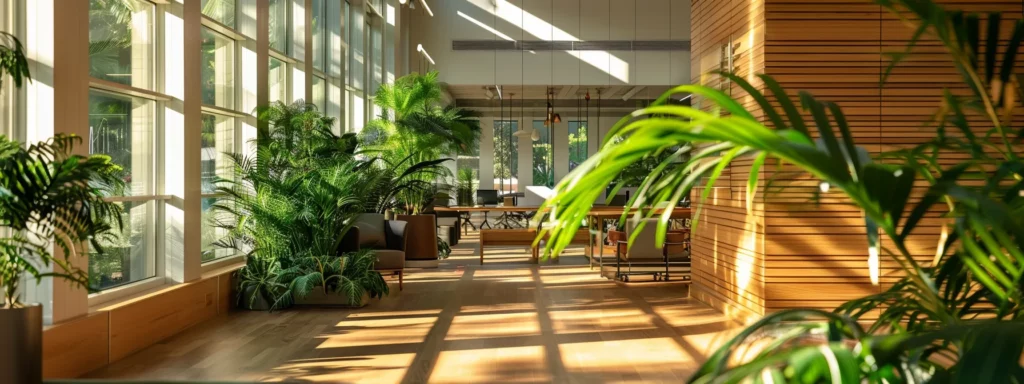Transforming an office environment doesn’t just impact the aesthetics; it influences productivity, mood, and overall employee well-being. From wall colors to the furniture layout, every detail plays a part in creating a workspace that’s not only functional but also inspiring. By adopting a strategic design approach, you can convert any bland office space into a vibrant hub of creativity and efficiency. Below, we explore several vital aspects of office design that can significantly influence the dynamics of your workplace.
Integrating Biophilic Design for a Breath of Fresh Air
Humans have an innate connection to nature, an aspect that can vastly benefit the office context through biophilic design. Integrating elements of nature into the workspace can reduce stress, enhance creativity, and improve overall job satisfaction. The calming presence of plants, access to natural light, and the use of natural materials can make a significant difference in employee morale.
One simple way to include nature is by incorporating fake outdoor plants into the office setting. These contribute to the aesthetic of nature without the maintenance hassle of real flora. Larger windows or even a living wall can also serve to bring the outside in, blurring the lines between the natural and built environments.
Moreover, natural textures and patterns can evoke the outdoors, with materials such as wood, stone, and textiles that mimic organic forms. Using these in design details can further solidify the connection to the natural world, even in more urban or industrial office setups.
Fostering Collaboration With Creative Commons Spaces
Common areas play a significant role in fostering a collaborative and interactive office culture. These spaces can encourage spontaneous meetings, brainstorming sessions, and a shared sense of community among employees. Designing common areas with flexibility in mind allows them to serve multiple functions, from casual lounges to project hubs.
Interactive features such as whiteboards, projectors, or even gaming consoles can transform common spaces into innovation centers that also offer relaxation and team bonding. Such areas should be comfortable and inviting to draw people in and promote a sense of ease during collaborative efforts.
It’s also crucial to consider the flow of traffic through common spaces. Strategic placement of furniture and design elements can guide movement and create natural gathering points without obstructing paths. The goal is to design an environment that supports both the needs of the individual and the dynamics of the team.
Innovative Furniture for Flexibility and Movement

The furniture in an office serves not only as a practical necessity but also as a catalyst for flexibility and movement. Investing in ergonomic designs and adjustable workstations can boost comfort, health, and productivity. Innovative furniture options like standing desks encourage employees to alternate between sitting and standing, promoting healthy circulation and reducing the risk of posture-related injuries.
Adding modular furniture that can be easily reconfigured provides a dynamic workspace that can adapt to various needs and team sizes. This flexibility supports a collaborative and agile office culture, where spaces are optimized for both individual work and group projects. Moreover, attractive and interactive furniture designs can stimulate creative thinking and ideation.
Visiting a new office furniture showroom can provide ideas and inspiration for pieces that integrate technology, comfort, and design. From desks with integrated charging stations to acoustical furniture that helps manage sound, the right furniture choices can have far-reaching effects on the efficiency and enjoyment of the workplace.
Smart Lighting Solutions to Boost Energy and Focus

Lighting is another key aspect of office design that influences mood and energy levels. The right lighting solutions can reduce eye strain, prevent fatigue, and enhance overall workplace efficiency. Natural light is the most beneficial and should be maximized wherever possible, but when it’s lacking, smart artificial lighting can fill the gap.
Implementing LED lights with adjustable color temperatures allows employees to tailor lighting to specific tasks and times of day, echoing the natural progression from warm morning light to cooler tones in the afternoon. Additionally, integrating motion sensors and dimmers can help conserve energy and provide the right amount of light when and where it’s needed.
Overall, a well-designed office environment plays a pivotal role in stimulating productivity, fostering collaboration, and promoting well-being among employees. By integrating elements like color psychology, biophilic design, innovative furniture, creative common spaces, and smart lighting solutions, any office can be transformed into a dynamic space that supports the multifaceted needs of its workforce. With these strategies in mind, companies can create a workplace that’s not just a place to work, but a source of inspiration and a reflection of their organizational culture and values.



